Creation: Good Old Young Universe Part III

A guest post today from my brilliant husband, Gregg.
The 6 types of evolution taught as fact in the average public school today, the first 5 being types of Darwinian evolution which are preached as religious beliefs, and the 6th being simple modifications within kind, or changes within kind, and not even really “evolution” are:
- Cosmic evolution
- Stellar evolution
- Chemical evolution
- Abiogenesis—Life from non-life
- Macro-evolution
- Micro-evolution (Variations within kind, not really evolution)
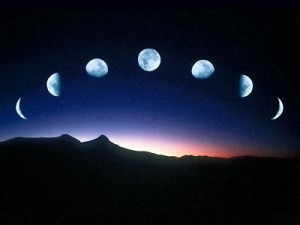 A Brief Recap
A Brief Recap
I posed the question, “How old is our planet, the Earth?” The factual answer is, no one knows.
Even vast amounts of time don’t prove Darwinism. But short amounts of time, young ages, finite periods in which change must occur directly and utterly refute Darwinism.
For the past few weeks, I documented evidence from the stars and from our solar system that the earth and the universe cannot be very old — based on scientific evidence alone. I documented evidence from comets, meteors and meteorites, our fellow planets in our solar system, and our sun. All of the empirical evidence suggests that the earth cannot be billions or even millions of years old.
This Sunday, I will continue to present facts about the age of the earth and the universe in which we exist. While opinions can vary as to the actual age of our planet, there are an astonishing number of factual evidences that our world is quite young.
Consider Evidence from Our Own Moon
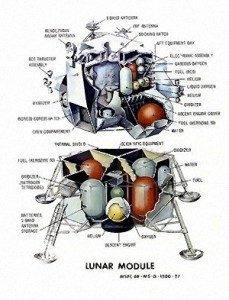 MOON DUST:Believe it or not, one of the reasons so much money was spent to send human beings to the moon was to measure how thick the dust on its surface was. Before the Apollo missions, Darwinists held fast to the fact that the earth and moon are the same age. It is believed, by many, that the earth and moon are billions of years old.
MOON DUST:Believe it or not, one of the reasons so much money was spent to send human beings to the moon was to measure how thick the dust on its surface was. Before the Apollo missions, Darwinists held fast to the fact that the earth and moon are the same age. It is believed, by many, that the earth and moon are billions of years old.
This created, for NASA and the contractors working on the Apollo missions, a problem known at the time as the “dust problem.” The problem arises because in just 5 to 10 billion years, even at only 3 or 4/10,000ths of an inch of dust accumulating per year this would produce 20-60 miles, or about 30-100 kilometers, of dust.
In view of this, NASA was deeply afraid to send men to the moon. Landing there, NASA speculated, astronauts would find themselves quickly buried in the miles and miles of deep, thin dust with no possiblity of escape and die. They took all kinds of precautions. Northrup Grumman, who had the contract to build the moon lander, designed giant landing pads that looked like huge serving plates to “slow the sinking into the dust” and lighter and lighter materials were employed both to save weight on take-off and to reduce the weight of the landing craft to help it attain volumetric equilibrium sooner, should it sink too deeply into the dust.
Eventually, the dust problem and the unknowns it brought to the table were just too great. NASA sent an unmanned lander to the moon’s surface in advance of the men. The lander made the surprising discovery that there was hardly any dust on the moon at all.
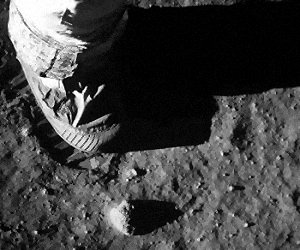 In spite of that discovery, Neil Armstrong was decidedly worried about the dust. In his autobiography, he recounts how he feared his lunar lander would sink deeply into the dust and that he and Edwin Aldrin would live the remainder of their few remaining days buried alive on the moon.
In spite of that discovery, Neil Armstrong was decidedly worried about the dust. In his autobiography, he recounts how he feared his lunar lander would sink deeply into the dust and that he and Edwin Aldrin would live the remainder of their few remaining days buried alive on the moon.
Of course, the moon is just as young as the earth, so they had no problem. There is no more than 2 or 3 inches of dust on the surface of the moon. And of course, that is just about the exact amount one would expect to find if the moon were only about 6000-8000 years old.
This has caused Darwinists to recently revise their lunatic theories to state that the moon might have been a captured comet or meteor or asteroid — all of which have been refuted rather quickly.
ORIGIN OF MOON DUST:A highly respected astronomer in the 1950s, one R.A. Lyttleton, said this: “[The] lunar surface is exposed to direct sunlight, and strong ultraviolet light and X-rays [from the sun] can destroy the surface layers of exposed rock and reduce them to dust at the rate of a few ten-thousandths of an inch per year. But even this minute amount could, during the age of the moon, be sufficient to form a layer over it several miles deep.”—R.A. Lyttleton, quoted in R. Wysong, Creation-Evolution Controversy, p. 175.
Turns out Dr. Lyttleton’s facts were correct. Solar radiation does indeed turn moon rocks into dust. In addition to this, the moon picks up dust from space and dust is created when the moon is struck by meterorites that smash the moon rocks into powder. However, studies have shown that only 1/60th of the thin dust layer on the moon originated from outer space. This has been corroborated by still more recent measurements of the influx rate of dust on the moon, and very recently by the purposeful man-made bombardment of the moon.
The scant few inches of dust on the moon’s surface are strong evidence that the moon cannot be older than a few thousand years, not millions of years, and certainly not billions of years.
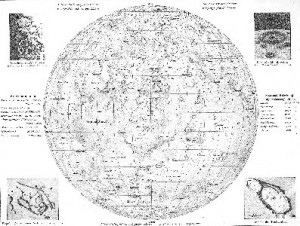 LUNAR SOIL:The dirt on the moon does not reveal the amount of soil mixing that would be expected if the moon were very old. Analysis of lunar soil completely negates the possibility that the moon could be older than a few thousand years.
LUNAR SOIL:The dirt on the moon does not reveal the amount of soil mixing that would be expected if the moon were very old. Analysis of lunar soil completely negates the possibility that the moon could be older than a few thousand years.
LUNAR ISOTOPES:One of the most surprising moon rock discoveries is almost never mentioned: Short-lived Uranium .236 and Thorium .230 were found in moon rocks. Short-term radioactive isotopes do not last long at all. They quickly half-life into their end product, which is lead. If the moon were even 50,000 years old, these short-life radioisotopes would long since have decayed over several half-lifes into lead. Instead, Uranium .236 and Thorium .230 were relatively abundant in the moon rocks. As a limiting factor, the scientific importance of this cannot be underestimated or explained by Darwinists. The evidence clearly indicates that the moon cannot be older than thousands of years, not millions, and positively not billions.
LUNAR RADIOACTIVE HEAT:Rocks brought by Apollo teams from the moon have been dated by the various radiometric methods. A variety of very conflicting dates have resulted from these tests, just as when applying any of these dating methods to terrestrial rocks. Even so, the factor of relatively high radioactivity in each of those rocks indicates an astonishingly young age for the moon.
LUNAR GASES:Several inert gases have been found on the surface of the moon. Scientists believe that these gases came from the sun, in the form of “solar wind.” Mathematical calculation reveals that, at today’s intensity of solar wind, the amount of inert gases found on the moon would be built up in 1000 to 10,000 years, and not one minute longer. These calculations are based on concentrations of Argon 36 and Krypton 84. Even 20,000 years would be far too lengthy a span of time. Therefore the moon could not be older than about 6000-10,000 years old, incontestably not millions, and unquestionably not billions.
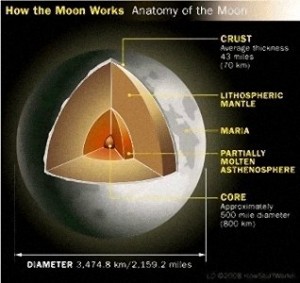 LUNAR PHENOMENA:A growing collection of data of transient lunar activity (moon quakes, lava flows, gas emissions, the recent man made bombardment, etc.) reveals that the moon is not a cold, dead body. It is still adjusting to inner stresses and is not yet in thermal equilibrium. Yet, all things considered, if the moon were very old it should not show any such thermal activity. It should not have a molten core. If it were a captured comet or asteroid, it would not have a molten core. It should be an ancient, cold, dead body which achieved thermal equilibrium perhaps a few million years ago — just a 4 billion year old cold space rock.
LUNAR PHENOMENA:A growing collection of data of transient lunar activity (moon quakes, lava flows, gas emissions, the recent man made bombardment, etc.) reveals that the moon is not a cold, dead body. It is still adjusting to inner stresses and is not yet in thermal equilibrium. Yet, all things considered, if the moon were very old it should not show any such thermal activity. It should not have a molten core. If it were a captured comet or asteroid, it would not have a molten core. It should be an ancient, cold, dead body which achieved thermal equilibrium perhaps a few million years ago — just a 4 billion year old cold space rock.
LUNAR RECESSION:For me, this is the most compelling evidence. Scientists have discovered and quantified two interesting lunar facts:
- The moon is already far too close to the earth, and
- it is gradually moving farther away from us.
This is called recession of the moon, or lunar recession. “The moon is slowly receding from Earth at about 4 centimeters [1 ¼ inches] per year, and the rate [of recession] would have been greater in the past. The moon could never have been closer than 18,400 kilometers [11,500 miles], known as the Roche Limit, because Earth’s tidal forces would have shattered it.” —Jonathan Sarfati, Creation Ex Nihilo, September 1979.
The Roche Limit, sometimes called the Roche Radius, is the distance within which a celestial body such as our moon, held together only by its own gravity, will disintegrate due to a second celestial body’s tidal forces — such as those the earth will exercise — exceeding the first body’s gravitational self-attraction. Due to tidal friction, the moon is currently slowly spiraling outward away from the earth.
Based on the rate at which the moon is receding from us, neither the earth nor the moon can be very old. The present rate of recession clearly indicates a young age for the earth-moon system.
Here’s why. If the moon were older—even a scant 20 to 30,000 years old,—it would at that earlier time have been so close that it would have fallen into the earth or shattered into dust and rock.
The Truth
 About 2000 years ago, the moon was closer to the earth than it is today. Think of the evidence of creation shining before us like a very clear trail that leads directly to the cross. Consider the timing the Creator had in mind when, in the hour of Christ Jesus’ death, a complete lunar eclipse cast the earth into darkness for three hours and the tidal stresses on the earth were so great that there were earthquakes all over the region. (Matthew 27:51-53; Mark 15:33; Luke 23:44-45) These earthquakes and the eclipse were recorded by historians from Rome to northern Africa and from Persia to Jerusalem. How brilliant and awesome is our God and how wonderful that science continues to confirm the works of His hands.
About 2000 years ago, the moon was closer to the earth than it is today. Think of the evidence of creation shining before us like a very clear trail that leads directly to the cross. Consider the timing the Creator had in mind when, in the hour of Christ Jesus’ death, a complete lunar eclipse cast the earth into darkness for three hours and the tidal stresses on the earth were so great that there were earthquakes all over the region. (Matthew 27:51-53; Mark 15:33; Luke 23:44-45) These earthquakes and the eclipse were recorded by historians from Rome to northern Africa and from Persia to Jerusalem. How brilliant and awesome is our God and how wonderful that science continues to confirm the works of His hands.
The truth is that creation is explained in perfect, logical, scientifically accurate detail for anyone who cares to investigate and the one who lays the explanation out for us is the One who is responsible for that act of creation in the beginning.
God Bless you and yours,
Gregg
Resources:
Additional Posts dealing with Creation and Darwinism


Keep these posts coming! They are so inspiring!